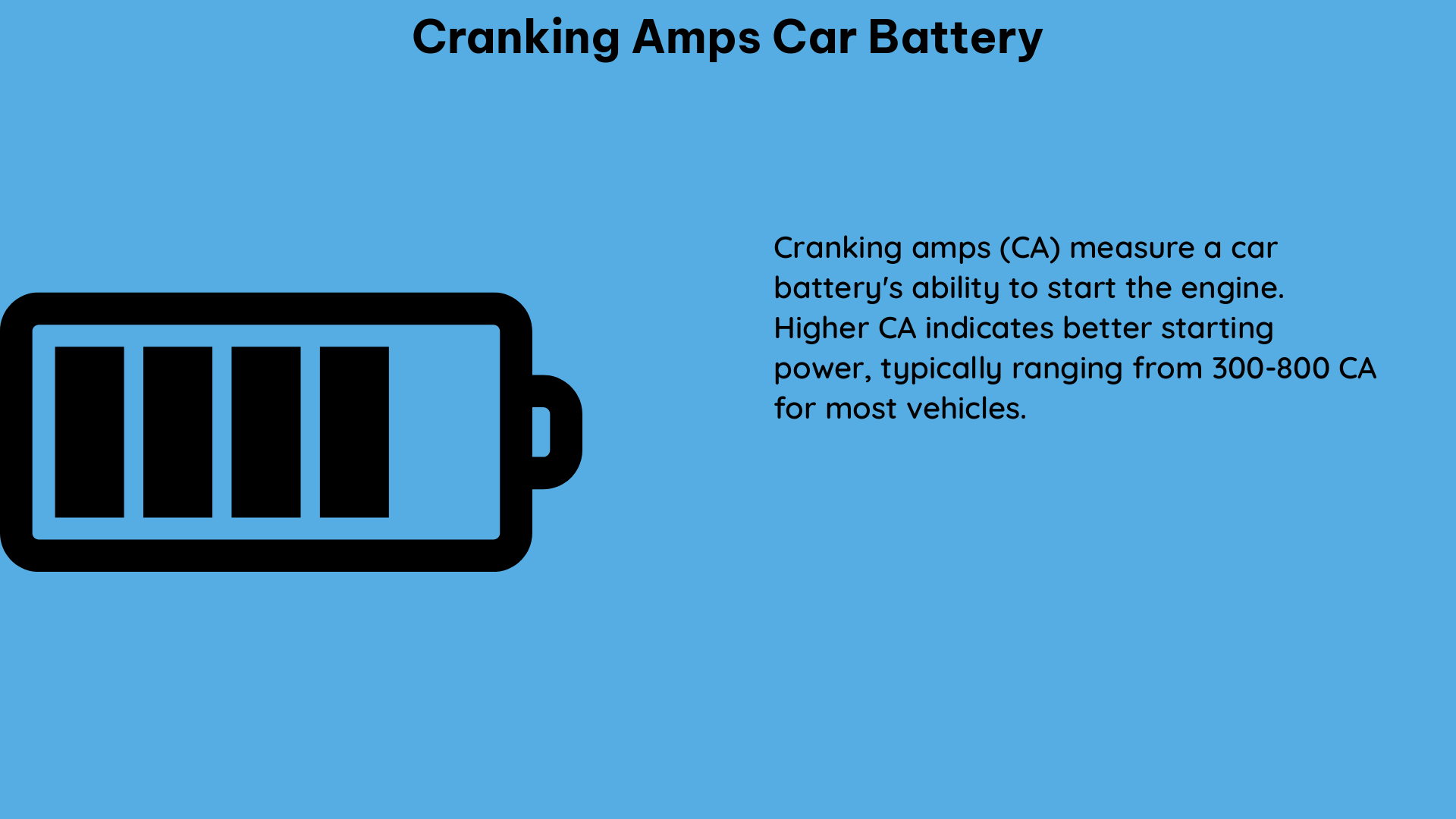Cranking Amps (CA) and Cold Cranking Amps (CCA) are crucial metrics that determine a car battery’s ability to deliver a high burst of power to crank the engine, especially in cold temperatures. These ratings are essential for ensuring reliable engine starts, particularly in colder climates. In this comprehensive guide, we’ll dive deep into the technicalities of CA and CCA, providing you with a thorough understanding of these critical battery performance indicators.
Understanding Cranking Amps (CA)
Cranking Amps (CA) measure the number of amps a battery can deliver at 32°F (0°C) for 30 seconds while maintaining a voltage above 7.2 volts. This rating is a crucial indicator of a battery’s ability to start the engine, as it reflects the battery’s capacity to provide the necessary power to crank the engine, even in moderately cold conditions.
The CA rating is determined by a standardized test procedure that involves the following steps:
- The battery is fully charged and then cooled to 32°F (0°C) for 24 hours.
- A discharge current equal to the specified CA rating is applied to the battery.
- The voltage is measured during the 30-second discharge period.
- To pass the test, the battery must maintain a voltage above 7.2 volts (1.2 volts per cell) for the entire 30-second duration.
A higher CA rating indicates a stronger battery that can deliver more power to crank the engine, making it a valuable metric when selecting a replacement battery for your vehicle.
Understanding Cold Cranking Amps (CCA)

Cold Cranking Amps (CCA) measure the same performance characteristics as CA, but at an even colder temperature of -18°C (0°F). This more stringent test is designed to simulate the extreme conditions that a battery may face during a cold-weather engine start.
The CCA rating is determined by a standardized test procedure that follows these steps:
- The battery is fully charged and then cooled to -18°C (0°F) for 24 hours.
- A discharge current equal to the specified CCA rating is applied to the battery.
- The voltage is measured during the 30-second discharge period.
- To pass the test, the battery must maintain a voltage above 7.2 volts (1.2 volts per cell) for the entire 30-second duration.
The CCA rating is often used as the primary indicator of a battery’s starting power, as it provides a more accurate representation of the battery’s performance in the harshest of winter conditions.
Comparing CA and CCA Ratings
While both CA and CCA ratings are important, the CCA rating is generally considered the more critical metric when selecting a car battery. This is because the CCA rating is a more stringent test that better reflects the battery’s ability to start the engine in extremely cold temperatures.
However, it’s important to note that the CA rating is still a valuable metric, as it provides insight into the battery’s performance in moderately cold conditions. In some cases, a battery with a higher CA rating may be a better choice if the vehicle is primarily used in milder climates.
When selecting a car battery, it’s essential to consider both the CA and CCA ratings, as well as other factors such as the battery’s size, type, and compatibility with the vehicle’s electrical system.
Measuring CA and CCA Ratings
To measure a car battery’s CA or CCA rating, you’ll need a specialized battery tester. These tools apply a load to the battery and measure the voltage drop to estimate the battery’s capacity to deliver power.
When using a battery tester, it’s important to follow the manufacturer’s instructions carefully to ensure accurate results. This may include:
- Fully charging the battery before testing.
- Cooling the battery to the appropriate temperature (-18°C or 0°F for CCA, 32°F or 0°C for CA) for 24 hours.
- Applying the specified discharge current and measuring the voltage drop.
- Comparing the results to the battery’s rated CA or CCA specifications.
It’s also important to note that the CA and CCA ratings can be affected by factors such as the battery’s age, condition, and the vehicle’s electrical system. If you’re experiencing starting problems with your vehicle, it’s essential to have the battery and electrical system checked by a qualified technician.
Conclusion
Cranking Amps (CA) and Cold Cranking Amps (CCA) are critical metrics that determine a car battery’s ability to deliver the necessary power to crank the engine, especially in cold temperatures. Understanding these ratings and how to measure them is essential for ensuring reliable engine starts and maintaining the overall health of your vehicle’s electrical system.
By following the guidelines and best practices outlined in this comprehensive guide, you’ll be well on your way to mastering the intricacies of cranking amps and selecting the right car battery for your needs.
References:
- How are CCA’s (Cold Cranking Amps) measured, specifically with regard to the load? – Electrical Engineering Stack Exchange
- Key Metrics of Battery Performance for Today’s Engines – Stryten
- Measuring car battery amps – Reddit
- BU-902a: How to Measure CCA – Battery University

The lambdageeks.com Core SME Team is a group of experienced subject matter experts from diverse scientific and technical fields including Physics, Chemistry, Technology,Electronics & Electrical Engineering, Automotive, Mechanical Engineering. Our team collaborates to create high-quality, well-researched articles on a wide range of science and technology topics for the lambdageeks.com website.
All Our Senior SME are having more than 7 Years of experience in the respective fields . They are either Working Industry Professionals or assocaited With different Universities. Refer Our Authors Page to get to know About our Core SMEs.